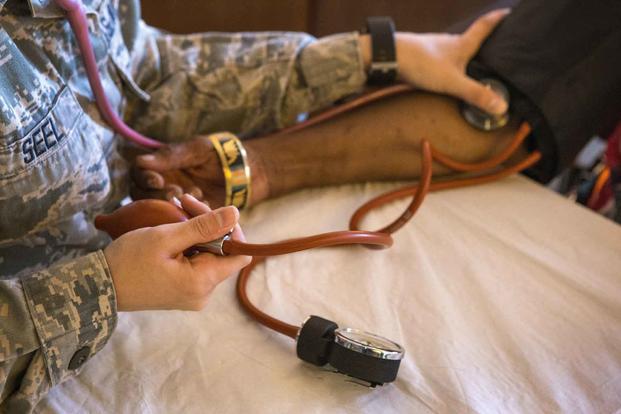An automated system designed to accelerate disability claims decisions at the Department of Veterans Affairs contributed to inaccurate ratings for 27% of claims filed for high blood pressure, a new report from the VA's inspector general has found.
The Automated Benefits Delivery System, introduced in December 2021 ahead of an anticipated flood of disability applications related to the PACT Act, pulls blood pressure readings and high blood pressure-related medical data from VA treatment records and creates a summary sheet that is reviewed by VA staff, known as rating veterans service representatives.
But a review by the VA Office of the Inspector General published Monday found that in samples of summary sheets, 37% of the first batch of 30 sheets were deficient, as were 57% of the second 30 sheets. These inaccuracies resulted in wrongful decisions by the ratings representatives for more than a quarter of the 60 claims.
The report did not detail the extent of the errors or say whether the decisions favored the veterans or the VA. It also covered a limited number of examples at a time when the technology was in development.
The report comes as a growing number of Vietnam-era veterans have filed claims under the PACT Act for high blood pressure, also known as hypertension, and have received 0% disability ratings for their condition, which has been linked to exposure for Agent Orange.
VA assigns a disability rating for service-connected conditions based on the disabling effect of an illness or injury. In many cases, high blood pressure can be controlled by medication and is not a hindrance to daily activities and employment -- a state that may result in a 0% disability rating.
According to the IG report, the errors in ratings assignment resulted from errors in summary sheets that included missing or inaccurate blood pressure readings, missing medications prescribed for high blood pressure and a lack of context as to where or when the readings were taken -- for example, in an emergency room or during a time of stress.
Larry Reinkemeyer, VA assistant inspector general for audits and evaluation and the report's lead author, said the issues with the system were largely technical, attributable to failures with the automation system recognizing data, and largely fixable.
The OIG recommended that VA make technology improvements, increase quality assurance and monitor all results for accuracy of summary sheets and final decisions. Also, the department should study whether the automated system is, in fact, speedier and better than the traditional process in which a veterans service representative gathers all the information.
"Failure to improve oversight increases the risk that eligible veterans will not receive the benefits to which they are entitled, and [the Veterans Benefits Administration] will invest additional funds in a process and technology that do not deliver the intended outcomes," Reinkemeyer wrote.
VA officials agreed, for the most part, with the recommendations. But they noted that the automation system was in its nascency when the Office of Inspector General conducted its review.
According to VA, the system is used at 16 prototype and pilot sites, where it has processed less than 8% of the total high blood pressure claims considered nationwide.
"At the time of the review, OIG was reviewing cases in the very early stages of the verify phase. Completion of prototyping and a pilot phase had not yet been complete, and technology was still being developed and enhanced," VA officials wrote in response.
The VA rolled out the Automated Benefits Delivery System with an aim to reduce the disability application time for claims submitted for common conditions in veterans, including high blood pressure, asthma, sleep apnea and prostate cancer.
VA officials said the technology "has been widely adopted by both industry and government to reduce administrative burden for employees," and at no point would the final decisions on claims be made by the system.
More than 1 million claims have been filed under the PACT Act, the law passed last year that broadened health-care and disability benefits for millions of former service members exposed to environmental pollutants and toxic chemicals while serving in certain locations overseas.
Of those claims, 570,000 have been decided, with nearly 80% approved. Of the 80% approved, however, roughly one-third have received a 0% disability rating, meaning that affected veterans have at least one service-connected condition under the law that is not disabling -- for example, high blood pressure, which has been linked to Agent Orange exposure, that is controlled by medication.
According to VA, other conditions that have received the 0% rating under PACT Act allowances include allergic rhinitis, maxillary sinusitis, bronchial asthma and "malignant growth of the genitourinary system," which includes prostate, testicular and other types of cancers that may be curable with surgery and treatment.
VA has a higher threshold for veterans to meet to receive a disability rating for hypertension than the medical definition. For disability rating purposes, VA regards hypertension as having a diastolic blood pressure (the lower number) as 90 mm or greater, or a systolic blood pressure (the top number) of 160 mm or higher with the lower number being less than 90 mm.
The American Heart Association and the Centers for Disease Control and Prevention classify high blood pressure in two stages, with the higher stage being systolic readings over 140 mm and diastolic being 90 mm and higher.
High blood pressure raises the risk of stroke, heart attack, heart failure and other health conditions.
VA Under Secretary for Benefits Joshua Jacobs said last week the department is reviewing its ratings schedule to determine whether it can be revised to address medically controlled conditions such as high blood pressure.
-- Patricia Kime can be reached at Patricia.Kime@Military.com.
Related: Special PACT Act Enrollment Period for Veterans Ends in September













